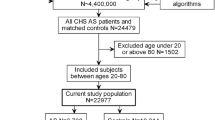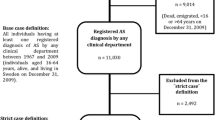Abstract
The objective of this study was to determine the prevalence, clinical pattern, and management of seronegative spondyloarthropathies (SpA) in the general adult population of Greece. This population-based study was conducted on a target adult (≥19-year-old) population of 14,233 subjects by rheumatologists who visited households in nine dispersed areas. An interview (standardized questionnaire) was conducted, clinical evaluation and laboratory investigation were done, and established diagnostic classification criteria were used. The age-adjusted and sex-adjusted prevalence (prevalenceasa) of SpA was 0.49% [95% confidence interval (CI): 0.38–0.60], with a male to female ratio of 5.5:1; the prevalence increased with age until the 59- to 68-year-old age group and declined thereafter. The prevalenceasa of ankylosing spondylitis (AS) and psoriatic arthritis (PsA) was 0.24% (95% CI: 0.16–0.32) and 0.17% (95% CI: 0.10–0.24), respectively. The mean age (years) at onset was younger in AS (25.83±6.5) than in PsA (45.24±12.94) (p<0.01). Familial clustering was noticed in 5.3% of AS probands. Sacroiliitis was observed in 39.8% and asymmetrical oligoarthritis in 40.6% of PsA patients. Fifty-nine percent of SpA patients had previously visited rheumatologists (91.3% diagnosed correctly vs 11.6% of those who visited other specialists, p<0.0005); 56.5% of the former had taken disease-modifying antirheumatic drugs compared to none of the latter. The SpA in Greeks are as common as in other European Caucasians, with a high male preponderance. The PsA onset occurs at an older age than AS and frequently presents with a spondylitic pattern. The correct diagnosis was arrived at and appropriate treatment was given when patients consulted rheumatologists.

Similar content being viewed by others
Abbreviations
- AS :
-
Ankylosing spondylitis
- CI :
-
Confidence interval
- DMARDs :
-
Disease-modifying antirheumatic drugs
- ESORDIG :
-
Epidemiological study of the rheumatic diseases in Greece
- ESSG :
-
European Spondyloarthropathy Study Group
- IBD-aA :
-
Inflammatory bowel disease-associated arthritis
- NSAIDs :
-
Nonsteroidal anti-inflammatory drugs
- Prevalence asa :
-
Age-adjusted and sex-adjusted prevalence
- PsA :
-
Psoriatic arthritis
- ReA :
-
Reactive arthritis
- SpA :
-
Seronegative spondylarthropathies
- uSpA :
-
Undifferentiated spondyloarthropathy
References
Hukuda S, Minami M, Saito T et al (2001) Spondyloarthropathies in Japan: nationwide questionnaire survey performed by the Japan Ankylosing Spondylitis Society. J Rheumatol 28:554–559
Boyer GS, Templin DW, Cornoni-Huntley JC et al (1994) Prevalence of spondyloarthropathies in Alaskan Eskimos. J Rheumatol 21:2292–2297
Saraux A, Guedes C, Allain J et al (1999) Prevalence of rheumatoid arthritis and spondyloarthropathy in Brittany, France. J Rheumatol 26:2622–2627
Bruges-Armas J, Lima C, Peixoto MJ et al (2002) Prevalence of spondyloarthritis in Terceira, Azores: a population-based study. Ann Rheum Dis 61:551–553
Andrianakos A, Trontzas P, Christoyannis F et al (2003) Prevalence of rheumatic diseases in Greece: a cross-sectional population-based epidemiological study in urban, suburban and rural adult populations. The ESORDIG study. J Rheumatol 30:1589–1601
Dougados M, van der Linden S, Juhlin R et al (1991) The European spondyloarthropathy study group preliminary criteria for the classification of spondyloarthropathy. Arthritis Rheum 34:1218–1227
van der Linden S, Valkenburg HA, Cats A (1984) Evaluation of diagnostic criteria for ankylosing spondylitis. A proposal for modification of the New York criteria. Arthritis Rheum 27:361–368
Silman AJ (2001) Ankylosing spondylitis and spondyloarthropathies. In: Silman AJ, Hochberg MC (eds) Epidemiology of the rheumatic diseases, 2nd edn. Oxford University Press, NY, pp 100–111
Braun J, Bollow M, Remlinger G et al (1998) Prevalence of spondyloarthropathies in HLA-B27 positive and negative blood donors. Arthritis Rheum 41:58–67
Renieri N, Stavropoulos C, Lepage V (1979) The distribution of HLA antigens and genes in the Greek population. Tissue Antigens 13:154–157
Kahn MA (1995) HLA-B27 and its subtypes in world populations. Curr Opin Rheumatol 7:263–269
Baddoura R, Awada H, Okais J et al (1997) Validation of the European Spondylarthropathy Study Group and B. Amor criteria for spondylarthropathies in Lebanon. Rev Rheum Engl Ed 64:459–464
van der Linden S, Valkenburg HA, De Jongh BM, Cats A (1984) The risk of developing ankylosing spondylitis in HLA-B27 positive individuals. A comparison of relatives of spondylitis patients with the general population. Arthritis Rheum 27:241–249
Johnsen K, Gran JT, Dale K, Husby G (1992) The prevalence of ankylosing spondylitis among Norwegian Samis (Lapps). J Rheumatol 19:1591–1594
Lawrence RC, Helmick CG, Arnett FC et al (1998) Estimates of the prevalence of arthritis and selected musculoskeletal disorders in the United States. Arthritis Rheum 41:778–799
Silman AJ (2001) Psoriatic arthropathy. In: Silman AJ, Hochberg MC (eds) Epidemiology of the rheumatic diseases, 2nd edn. Oxford University Press, NY, pp 85–99
Veale DJ (2000) The epidemiology of psoriatic arthritis. Fact or fiction? J Rheumatol 27:1105–1106
Shbeeb M, Uramoto KM, Gibson LE, O’Fallon WM, Gabriel SE (2000) The epidemiology of psoriatic arthritis in Olmsted County, Minnesota, USA, 1982–1991. J Rheumatol 27:1247–1250
Alamanos Y, Papadopoulos NG, Voulgari PV et al (2004) Epidemiology of ankylosing spondylitis in Northwest Greece, 1983–2002. Rheumatology (Oxford) 43:615–618
Alamanos Y, Papadopoulos NG, Voulgari PV et al (2003) Epidemiology of psoriatic arthritis in Northwest Greece, 1982–2001. J Rheumatol 30:2641–2644
Andrianakos A, Trontzas P, Voudouris C (2004) Epidemiology of rheumatic diseases in Greece: author reply. J Rheumatol 31:1670–1671
Khan MA (2002) Update on spondyloarthropathies. Ann Intern Med 136:896–907
Kaipiainen SO, Aho K, Heliövaara M (1997) Incidence and prevalence of ankylosing spondylitis in Finland. J Rheumatol 24:496–499
Will R, Edmunds L, Elswood J, Calin A (1990) Is there sexual inequality in ankylosing spondylitis? A study of 498 women and 1202 men. J Rheumatol 17:1649–1652
Carbone LD, Cooper C, Michet CJ et al (1992) Ankylosing spondylitis in Rochester, Minnesota, 1935–1989. Is the epidemiology changing? Arthritis Rheum 35:1476–1482
Machtey I (1994) Sex ratio in spondyloarthropathies (letter). J Rheumatol 21:1978–1979
Kaipiainen-Seppänen O (1996) Incidence of psoriatic arthritis in Finland. Br J Rheumatol 35:1289–1291
Kennedy LG, Will R, Calin A (1993) Sex ratio in the spondyloarthropathies and its relationship to phenotypic expression, mode of inheritance and age of onset. J Rheumatol 20:1900–1904
Zink A, Listing J, Klindworth C, Zeidler H (2001) The national database of the German collaborative arthritis centers: structure, aims, and patients. Ann Rheum Dis 60:199–206
Braun J, Pincus T (2002) Mortality, course of disease and prognosis of patients with ankylosing spondylitis. Clin Exp Rheumatol 20 [Suppl 28]:S16–S22
Boumpas D, Illei G, Tassiulas I (2001) Psoriatic arthritis. In: Klippel JH (ed) Primer of the rheumatic diseases, 12th edn. Arthritis Foundation, Atlanta, Georgia, pp 233–237
Veale D, Rogers S, Fitzgerald O (1994) Classification of clinical subsets in psoriatic arthritis. Br J Rheumatol 33:133–138
Kirwan J, Edwards A, Huitfeldt B et al (1993) The course of established ankylosing spondylitis and the effects of sulphasalazine over 3 years. Br J Rheumatol 32:729–733
Author information
Authors and Affiliations
Corresponding author
Appendix
Appendix
In addition to the authors the following physicians are members of the ESORDIG study group: F. Christoyannis, P. Dantis, A. Georgountzos, D. Karamitsos, E. Kaskani, G. Kaziolas, L. Kontelis, P. Krachtis, Z. Nikolia and E. Tavaniotou.
Rights and permissions
About this article
Cite this article
Trontzas, P., Andrianakos, A., Miyakis, S. et al. Seronegative spondyloarthropathies in Greece: a population-based study of prevalence, clinical pattern, and management. The ESORDIG study. Clin Rheumatol 24, 583–589 (2005). https://doi.org/10.1007/s10067-005-1106-9
Received:
Revised:
Accepted:
Published:
Issue Date:
DOI: https://doi.org/10.1007/s10067-005-1106-9




